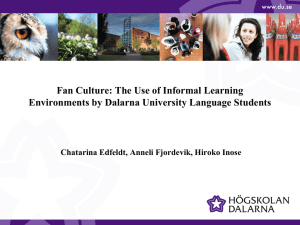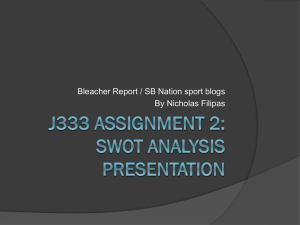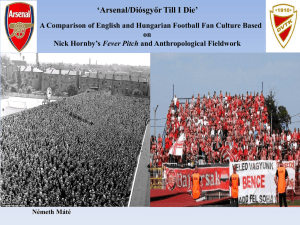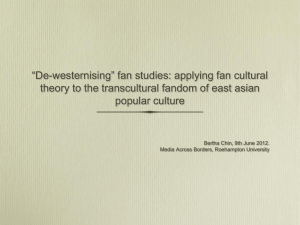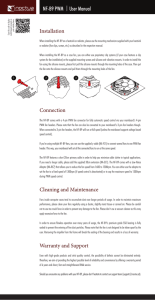Football “fanship”
advertisement
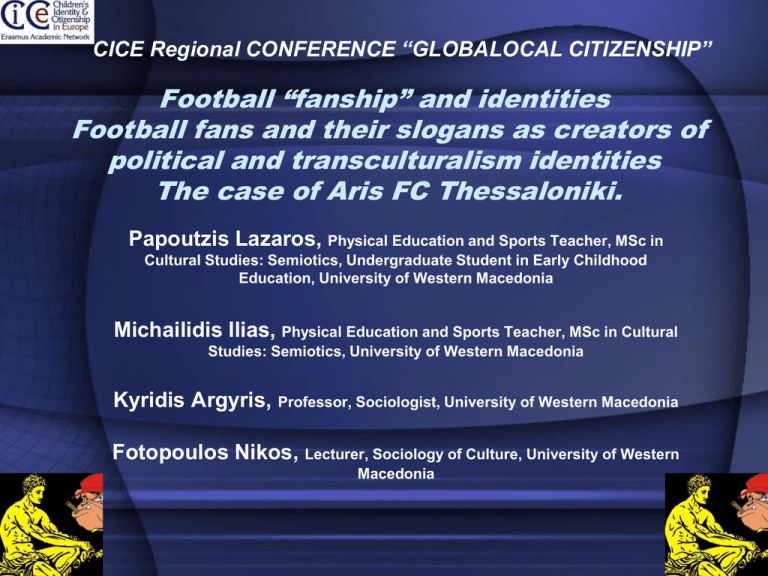
CICE Regional CONFERENCE “GLOBALOCAL CITIZENSHIP” Football “fanship” and identities Football fans and their slogans as creators of political and transculturalism identities The case of Aris FC Thessaloniki. Papoutzis Lazaros, Physical Education and Sports Teacher, MSc in Cultural Studies: Semiotics, Undergraduate Student in Early Childhood Education, University of Western Macedonia Michailidis Ilias, Physical Education and Sports Teacher, MSc in Cultural Studies: Semiotics, University of Western Macedonia Kyridis Argyris, Professor, Sociologist, University of Western Macedonia Fotopoulos Nikos, Lecturer, Sociology of Culture, University of Western Macedonia Introduction In the domain of cultural studies, we focus on the sociology of sports and fanship (Brown,1998) as it is represented on the logos of fan clubs of Aris FC Thessaloniki. In specific we are interested in the cultural perception of icons-symbols and linguistic messages in slogans, produced by the fans. Amongst Gelder’s six key way proposal in which subcultures can be identified, we use in order to interpret the corpus: • those that refer to the negative relations to work/class • the association with territory, rather than property • the refusal of the banalities of ordinary life and massification (Gelder 2007). Culture and Cultural Studies • In an effort for a definition of culture and its content, Williams (1958) argues that this refers to both the symbolic and the material scope. • The cultural studies understand culture as a way of life, ideas, attitudes, languages and a range of cultural practices, texts, uniforms, architecture. Social identities • The procedure of shaping the social identity is based on the molding process of social knowledge and attitude • Identity is a product of contact and not of isolation • When a person starts to be recognized as a member of a group and not another for him/her and the team members but also for the members of other groups, acquires identity • We should think of identity as a “production”, which is never complete, always in process and always constituted within, not outside, representation (Hall, 1990). Football and identities • Football is a powerful catalyst for social identities. Football teams and matches are usually a primary motivating factor for assertion and celebration of various identities, whether they be local, religious, ethnic, professional etc. • Football condenses, like the best drama plays, the main themes of our times (Bromberger C. , 1993). Football teams and fan clubs represent something, some identity, some positive identification vs to many others, in a extremely expressive way. • Hall and Du Gay (1996:4) consider that identities are mainly connected to the way people use historical, discursive and cultural resources. Attention is invested in the social representations of identity, the “narrativisation of the self”. Fans and Citizenship • • • • Fans are individuals and have individual rights - but these rights are not invariable, and their citizenship constructs itself around groups of people with specific cultures and histories. Citizenship involves itself in a multilogical discussion allowing different ways of thinking to be synthesized, modified and adjust, as part of a dynamic work in progress. As citizenship is a public identity it involves interest in different issues and it takes place in different social environments. Thus the discussion for the civic condition can take place in the expression of the fan identity as part of the every-day life. The aim • In this context we try to find the common elements among the fan-identity and the active citizenship for young people. • We focus on the transculturalism identities as they appear through the symbols and the representations young people choose. Methodology • We apply the socio-semiotic analysis (Kress, 1996) in order to de-construct the references to new identities and transculturalism. • As far as it concerns to the linguistic messages, content analysis is used applying the quantitative thematic methodology. The Data • The total sample consists of 79 fan stickers and 100 fan slogans, taken from ARIS fan clubs (1988-2010). • Amongst them there are 25 fan stickers and 15 slogans containing political references about citizenship and transculturalism. A fan slogan «Fans are allover earth…you cannot put ideals in prison» In red color we can see the identity-name of the fan club «SUPER 3 KATERINI» Fan slogan analysis • The linguistic material can be analyzed following the method of R. Barthes on the denotation and connotation to the use of words and production of myths. Followers of a sub-group of a subculture, as defined by the dominant culture, the slogan language (e.g, ibid) identified themselves as the dominant group, because "there throughout the Earth”, so it seems to claim the majority and the universality . • The fan clubs are recruited within the meaning and political terminology of 'ideals‘ which are not imprisoned and so obtain the identity: Fans all over Earth Team Ideals Fan sticker semiotic analysis • The tawny backround (black-yellow) means the official colors of Aris F.C and the red-colored letters link to the official colors of Aris fan clubs (Super 3). The crowd of fans have their hands raised, especially the left fist which indicates rebellion and opposition. • The black flags and fists together, mean political demonstration. • In the subtitle, the colors which are selected reflect the fans’ identity of the specific territories (Neapoli – Sykies). • The Bulldog as symbol of the fan club declares and indicates the reported. • The composition-scenario resulting from the perceived image horizontally and spatially registered in three parallel horizontal bands: a (linguistic hypertitle) + b (crowd design ) + c (lingual subtitle + indicator) => composition. • Syntactically, the central information is given in the center (b) with variables (Hayes, N. 1998) color and gesture, which mean the political-revolutionary identity of the fans vs the indicator-Bulldog. • In this case we can “read” an active dimension of citizenship + fans identity + action. • As shown by the high rate of virtuality of this image as a sign, fans identity to the c (spatial axis) is involved with the youthful, revolutionary identity on the b (horizontal axis) in a common field of youth subculture, as defined by the British School and the Cultural Studies. • On the contrary, on the linguistic sign we read in specific the fan identity-culture with block letters: REVENGE AND FIGHT as an incentive to attack. • The subtitle-visual message indicates the athletic determination of the fan club. • In particular, the use of symbols and algorithmic functions – in relation to the captions, which associate fan slogans, resulting scenarios and actions that recruit and read about the emphasis given to sociopolitical references. Discussion • As it appears, young people tend to construct their fan identity through the post-modern perception of citizenship. • Many signifiers have been found about the youth demonstration against government’s, police’s and fascism’s power. • The youth’s new identity is revealed through inter-cultural symbolism: “ A.C.A.B. (All Caps Are Bastards) ” and aggressive icons typically produced by anarchist, socialistic, young people. • It seems that even in the context of sports subcultures young students need to produce discourses versus the majority of adult’s established power as Foucault (1966) had already determined. Thank you for your attention


